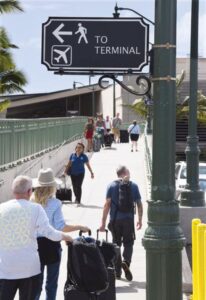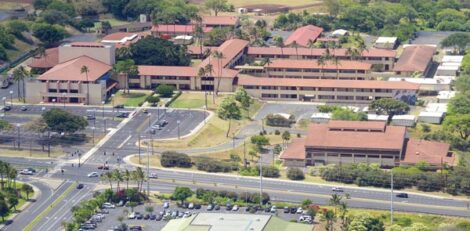Maui County lawmakers mull wins, defeats as session ends
Some happy to see key projects funded, but raised concerns over the final budget
Lawmakers feel Maui County fared well this legislative session, with funding for a variety of local projects, bills passed to address the lack of medical professionals as well as legislation and funding to help ease the housing crisis.
But a few Maui County legislators were among the House members who voted against the state budget or voted yes with reservations during the last day of businesses for the 2023 session on Thursday at the State Capitol.
Freshman Rep. Elle Cochran said on Friday that she opposed the measure because “it’s clearly about not enough information.”
“I don’t feel it was an open and transparent process for me to understand exactly how things got into this budget,” said Cochran, who was joined by veteran lawmakers in casting their dissent vote. “I don’t know it (reasons for the changes), thereby uncomfortable attaching my name to this document.”
Cochran, who represents House District 14, which includes Maalaea, Lahaina, Kahana, Kahakuloa and Waihee, is a former Maui County Council member. She said amendments and changes to bills on the county level were all available for members to see.
She also referenced comments made Thursday on the House floor by veteran Oahu lawmaker Della Au Belatti, who also raised issues over how the budget bill changed from last week until now.
Longtime Maui Rep. Justin Woodson also had concerns and voted yes, but with “serious reservations.”
“The Maui County delegation largely worked well together to produce for Maui County, but there was some sort of disconnect in K-12 and higher education funding,” he said Friday.
Woodson, who represents House District 9, which includes Kahului and a portion of Wailuku, was concerned that the budget for the state Department of Education’s operations was $167 million (in general funds) less than what Gov. Josh Green had asked for.
Woodson referenced the state’s budget surplus of $2 billion as well as economic forecasts, and questioned why Green’s request could not be fully funded.
Woodson said even if he did not hold the position as chairman of the House Committee on Education, he would still raise his concerns over the lack of funding for the DOE.
He added that cuts and changes took place after he and fellow House members voted for their version of the budget.
Maui County Reps. Terez Amato and Mahina Poepoe also voted yes with reservations.
Fellow Maui Rep. Troy Hashimoto, who voted in favor of the budget, pointed out that lawmakers can’t get everything they want in the budget.
“I think they have a hard time looking at the bigger picture. I think overall it was a solid budget, it funds a lot of areas that are critical,” said Hashimoto, who represents House District 10, which includes Wailuku, Waikapu and a portion of Waiehu.
“One of my biggest focuses is housing, obviously, I think we’ve invested well in housing,” he said Friday.
He said a “substantial amount” of funding went to housing, including lower-income housing and workforce housing.
“You just have to keep focused, that you aren’t going to get every single thing that you want,” he said. “The big thing is we are trying to make sure that we are ready for a potential downturn. I think people wanted to spend a lot. But you have to also be prepared that the economy may be teetering, we don’t know.”
House Speaker Scott Saiki addressed the budget opposition during a news conference Thursday afternoon. He said that when the legislative session began in January, there was an “almost unprecedented $2 billion surplus and the surplus over the course of the four-month session kind of dwindled a little after the Council of Revenues made a projection after bargaining awards came in, after the governor’s message came down late, so that number dwindled.”
He added that there is a new dynamic in the House.
“What you see here, there is a generation shift where in the House with the membership, members are willing to voice their opinion on legislation,” Saiki said. “But it’s something that I’ve always encouraged. I’ve always told our House members, that their role here is to vote their conscience.”
House Finance Committee Chairman and Maui Rep. Kyle Yamashita said that representatives see the House version of the budget, but details also have to be decided upon with the Senate, and that’s where things can change, as the two sides need to agree.
“For me, it’s a biennium budget, so we can still address it next year,” he said.
Veteran Maui Sen. Gil Keith-Agaran, who is vice chairman of the Senate’s Ways and Means Committee where he primarily handles funding for capital improvement projects, said that on the Senate side, “I think we were kept pretty well informed” on what the changes were in the budget.
Like Hashimoto, he also said that legislators “cannot get everything” they want in the budget.
The Central Maui senator said that the governor’s proposed budget is used basically “as a guide” on how and where money is allocated.
He also shared concerns about legislators being cautions about spending amid fears of slower economic growth.
No senators voted against the budget bill.
Bills backing health care
Some of the measures pushed by Maui County lawmakers that did get through centered on health care, a critical issue for a community with limited hospitals and shortages of health care workers.
Keith-Agaran pointed to a bill he co-sponsored to adopt the Interstate Medical Licensure Compact, which will streamline the recruitment of medical providers with out-of-state licenses.
He also noted a bill by Hashimoto that passed and that will expand the bridge program at the University of Hawaii-Maui College to help with training and educating certified nurses aides to move up to licensed practical nurses, which is something that will help long-term care facilities such as Hale Makua with staffing shortages.
With the shortages, there is limited ability to take in more patients and to receive patients from Maui Memorial Medical Center.
Also in the budget is $30 million in fiscal year 2024 and 2025 allocated toward increased reimbursements for medical service providers for Medicaid patients.
During this session, doctors from Maui and across the state supported a bill that would make them exempt from the general excise tax for treating patients who are elderly, poor, active duty or retired military with Medicare, Medicaid or TRICARE coverage.
Physicians said the measure would have helped them keep their businesses afloat, attract new doctors and keep local physicians at home.
Even though Cochran was not happy about the legislative process, she said, “I’m fairly happy with things,” in regards to getting money for housing for teachers as well as improvements to Kamehameha III Elementary in her district.
She was also pleased with the passage of a bill she introduced in the House and that Maui state Sen. Angus McKelvey, whose district also includes West Maui, introduced on the Senate side. The bill aims to speed up construction of the West Maui hospital by authorizing special purpose revenue bonds to assist the West Maui Hospital Foundation in constructing the facility.
Cochran and Keith-Agaran said the bill does not use any taxpayer money, but could help the foundation with obtaining funding.
Hashimoto also pointed to the funding for Maui Memorial Medical Center, with the Legislature allocating a subsidy of $22 million for this coming fiscal year.
He said the operating subsidy is supposed to go down each year — since the hospital came under the operations of Maui Health in 2017 — but he said the Legislature allocated funding that the hospital asked for because of the higher costs of doing business, a need to bring in traveling nurses to fill holes with staffing and the recent United Public Workers strike.
Hashimoto said he didn’t want to get into the way of operations, noting the hospital has obligations such as funding contracts. He also said the hospital also received funding for capital improvement projects.
Another critical issue was interisland transportation. Sen. Lynn DeCoite, whose District 7 includes East Maui, Upcountry, Molokai and Lanai, said she was “disappointed” that a bill she was involved in introducing that would establish an airline subsidy pilot program at Molokai airport to assist airlines in offsetting costs of operations did not make it through this year. However, she is “encouraged” that her Senate concurrent resolution passed, urging the state Department of Transportation to establish a working group to evaluate options that provide additional air service to remote and underserved communities across the state.
“I am hopeful that this working group will come up with meaningful solutions to address the air travel hurdles, including addressing the airfare costs, that the residents of Molokai, Lanai and other rural areas across the state experience every day,” she said.
Hashimoto also noted the capital improvement project and operational funds allocated to the county, saying “there will be a lot coming to Maui through those avenues as well.”
“Maui County did very well, I think, that is in my mind top priority for us,” he said. “Just making sure we get our fair share for our community needs and we also need to take a look at a lot of our nonprofits got quite a bit of grant in aid.”
Some larger and notable allocations on Maui include:
• $37.7 million for Kahului Airport improvements, including a new TSA checkpoint.
• $35 million for Kahului Harbor improvements.
• $25 million for Baldwin High School athletic facilities.
• $23.5 million for a new Waikapu wastewater treatment facility.
• $10 million for the Upcountry agricultural park.
• $1.25 million for flood prevention and mitigation at Kulanihakoi and Waipuilani Gulch.
* Melissa Tanji can be reached at mtanji@mauinews.com.
- Improvements to the Kahului Airport are among the big-ticket items in the state budget. While happy with some of the projects included in the budget, some Maui County state lawmakers still raised issues with the budget as a whole as the session wrapped up this week. The Maui News / MATTHEW THAYER photo
- Baldwin High School is seen from the air in 2020. The Maui News file photo





